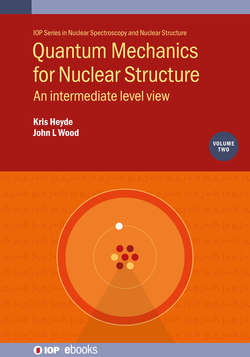Читать книгу Quantum Mechanics for Nuclear Structure, Volume 2 - Professor Kris Heyde - Страница 9
На сайте Литреса книга снята с продажи.
1.1 Rotations in (3, R)
ОглавлениеOne way to describe a rotation in (3, R) is in terms of rotation in a plane through a specified angle1. This is defined in terms of an axis of rotation nˆ and an angle ϕ. The axis nˆ is perpendicular to the plane defined by the initial and final orientations of the vectors V⃗, V⃗′: R(ϕ)V⃗=V⃗′. The difficulty lies in ascertaining the direction of nˆ. Although this ‘axis-angle’ parameterisation or Darboux parameterisation is simple in principle, it is difficult to use in practice.
The most widely used practical parameterisation of rotations in (3, R) is in terms of Euler rotations. Consider a space-fixed coordinate frame Oxyz and a body-fixed coordinate frame Ox¯y¯z¯. The orientation of an object can be specified by the rotation R that rotates the Ox¯y¯z¯ frame into the Oxyz frame. This can be done in three steps as illustrated in figure 1.1.
Figure 1.1. The Euler angles (α,β,γ) defined in terms of a three-step sequence of rotations that take an intrinsic or body-fixed frame Ox¯y¯z¯ into a space-fixed frame Oxyz. Note that the axes of rotation are: Oz¯; the line of intersection of the Ox¯y¯ and Oxy planes, OY; and Oz. In Step I, y¯ rotates to Y and z¯ remains fixed; in Step II, z¯ rotates to z and Y remains fixed; in Step III, Y rotates to y and z remains fixed. Further, note that the ranges of the angles are: 0⩽α<2π, 0⩽β<π, 0⩽γ<2π. This results in an ambiguity for the rotation β=0, (α,0,γ)≡(α′,0,γ′) if α+γ=α′+γ′: this is referred to as ‘gimbal lock’ (where ‘gimbal’ refers to the rotation device or mechanical operator). This figure is adapted from that found on the Easyspin website.
Figure 1.1 depicts the following:
R(α,β,γ)=Rz(γ)RY(β)Rz¯(α).(1.1)
Note the order of the three rotations. The problem is that these three rotations are about axes belonging to three different frames of reference. The three rotations on the right-hand side of equation (1.1) can be restated in terms of a single frame of reference using similarity transformations, specifically
Rz(γ)=RY(β)Rz¯(γ)RY−1(β)(1.2)
and
RY(β)=Rz¯(α)Ry¯(β)Rz¯−1(α).(1.3)
Thus,
∴R(α,β,γ)=RY(β)Rz¯(γ)Rz¯(α);(1.5)
and, since Rz¯(γ) and Rz¯(α) commute,
∴R(α,β,γ)=RY(β)Rz¯(α)Rz¯(γ),(1.6)
∴R(α,β,γ)=Rz¯(α)Ry¯(β)Rz¯(γ).(1.8)
Note the new order of the three rotations (cf. equation (1.1)).
